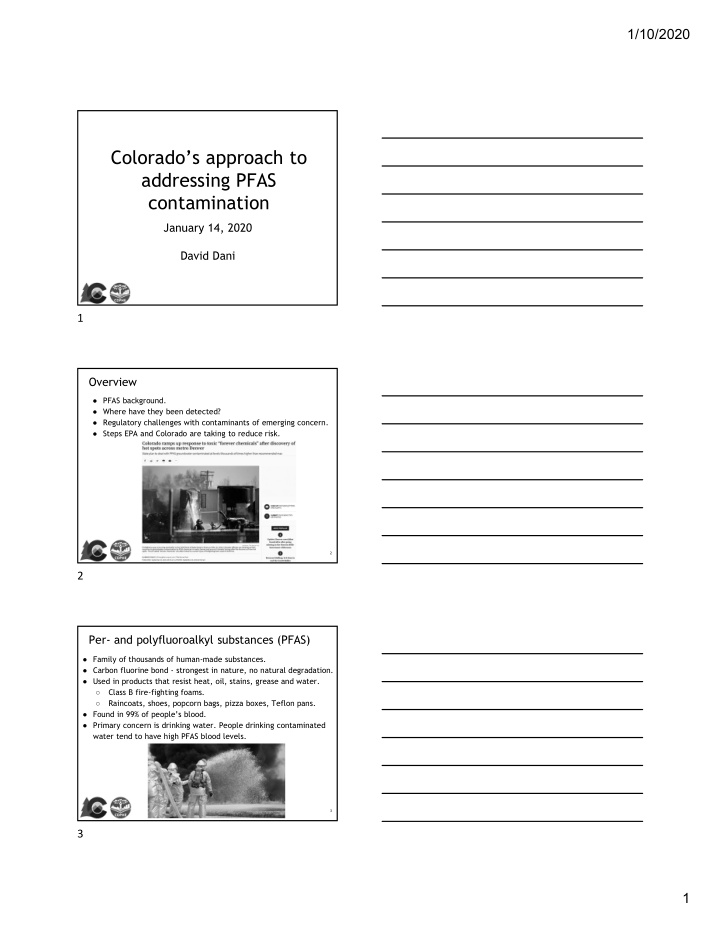



1/10/2020 Colorado’s approach to addressing PFAS contamination January 14, 2020 David Dani 1 Overview ● PFAS background. ● Where have they been detected? ● Regulatory challenges with contaminants of emerging concern. ● Steps EPA and Colorado are taking to reduce risk. 2 2 Per- and polyfluoroalkyl substances (PFAS) ● Family of thousands of human-made substances. ● Carbon fluorine bond - strongest in nature, no natural degradation. ● Used in products that resist heat, oil, stains, grease and water. ○ Class B fire-fighting foams. Raincoats, shoes, popcorn bags, pizza boxes, Teflon pans. ○ ● Found in 99% of people’s blood. ● Primary concern is drinking water. People drinking contaminated water tend to have high PFAS blood levels. 3 3 1
1/10/2020 PFAS and health ● High cholesterol. ● Liver damage. ● Decrease vaccine effectiveness. ● Asthma. ● Thyroid disease. ● Decrease fertility. ● Pre-eclampsia. ● Lower birth weight. ● Possible kidney & testicular cancer. EPA PFAS drinking water health advisory (non-regulatory) 2016: PFOS + PFOA < 70 ng/L 4 4 EPA’s process to establish drinking water standards EPA.gov 5 5 PFAS contamination impacting water supplies Hu, et al. 2016. ES&T Letters: 3(10), pp 344–350. 6 6 2
1/10/2020 State response Establish Develop Reduce risk collaboration solutions Communication - Treatment - design Agencies - EPA, local potentially affected and install health, water systems, potential responsible Decrease water levels - Pursue regulatory system operation, authority - further Resources – staff, alternate sources reduce pollution and funding, hyrology and exposure risk sample data GAC Ion exchange Pipeline install 7 7 Whose authority? Health advisory challenges ● Health advisory ≠ Maximum Contminant Level (MCL) ○ Not regulated under Safe Drinking Water Act ○ No clarity on water system actions or communicating risk ● Health advisory ≠ clean-up level ○ Not regulated under CERCLA/Superfund ● Fire fighting foam used as intended ≠ solid waste ○ Not regulated RCRA 8 8 2019 EPA PFAS Action Plan ● Proposed regulatory determination for PFOA and PFOS in 2019. ● Determining if PFOA and PFOS are CERCLA hazardous substances. ● Determining if regulation is appropriate for broader class of PFAS. ● Developing toxicity assessments for PFBS, PFBA, PFHxA, PFHxS, PFNA, PFDA, and GenX. ● Including a larger group of PFAS in UCMR 5 for systems serving 3,300 and above. ● Developing guidance/toolkits for communications, cleanup, etc. 9 9 3
1/10/2020 PFAS in National Defense Authorization Act ● Doesn’t designate PFAS as CERCLA hazardous substances or require PFAS drinking water MCL. ● Drinking water monitoring in UCMR 5 (2023-2025). ● PFAS releases will be reported to EPA’s Toxics Release Inventory. ● $100M per year in public water system grants. ● EPA to publish guidance on disposal/destruction of PFAS materials. ● Research health/environmental effects, monitoring, remediation. ● USGS to develop detection standards and sample nationwide. ● DOD to phase out PFAS foams by Oct 2024. 10 10 State actions to address PFAS in absence of federal standards 11 11 CDPHE PFAS Action Plan ● Break chain of exposure. ● Statewide monitoring to identify impacted drinking water. ● Develop inventory of contaminated sites with EPA. ● Regulatory authority. 12 Journal of Exposure Science & Environmental Epidemiology volume 29, pages131–147 (2019) 12 4
1/10/2020 PFAS drinking water sampling project ● Free PFAS testing for drinking water using emergency supplemental funds approved by Joint Budget Committee. ● All community and non-transient, non-community public water systems can apply for these funds. ● We’ll share results with systems and publish them on our website. ● If results are above level of concern, we’ll coordinate with water system to notify public and identify options to reduce exposure. 13 CDC website 13 PFAS Narrative Policy Workgroup Objectives ● Narrative provisions in Regulations 31 and 41 to limit PFAS contamination entering surface water and groundwater. ● Implementation in Colorado Discharge Permit System ● Initial monitoring: based on survey results, 28 PFAS species. ● Continued monitoring and source investigation. ● Effluent limits. ● CDPHE will propose policy to WQCC in May 2020. ● For more information: colorado.gov/cdphe/PFCS 14 14 PFAS Narrative Policy Translation Levels ● Division should consider permit effluent limits if exceeded. ● Grouped based on health effects. ● Levels based on relative toxicity. Developmental Endocrine Renal 15 15 5
1/10/2020 Fire Fighting Foams Control Act (HB 19-1279) ● Prohibits use of PFAS foam for training or testing. ● Prohibits sale of PFAS foam by August 2021. ● Requires CDPHE to survey fire departments every 3 years on amount of PFAS foam held, used, and disposed of. ● Results were due October 31 and report due January 1. ● 89 of 331 fire departments, airports, and industries responded. 16 16 Thank you! What are your questions? More information available at colorado.gov/cdphe/PFCS David Dani david.dani@state.co.us 303-692-3605 17 17 6
Recommend
More recommend